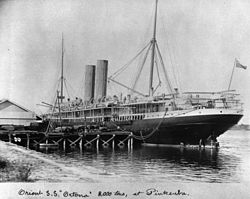Ortona (ship)
|
||||||||||||||||||||||
|
||||||||||||||||||||||
|
||||||||||||||||||||||
|
||||||||||||||||||||||
|
||||||||||||||||||||||
The Ortona (I) was a passenger steamer of the British shipping company Pacific Steam Navigation Company put into service in 1899 , sold in 1906 and renamed Arcadian in 1910 . On April 15, 1917, the ship was sunk in service as a troop transport by a German submarine in the Mediterranean , where 277 crew members and military personnel were killed.
Passenger ship
The 7,945 GRT steamship was built at the Vickers, Sons & Maxim shipyard in Barrow-in-Furness and put into service for the joint Australian service of the Pacific Steam Navigation Company (PSNCo) and the Orient Steam Navigation Company (Orient Line). The 152.4 meter long and 16.85 meter wide passenger and mail ship was launched on July 10, 1899 and was christened Ortona . It was a single building without a sister ship. The Ortona was able to take 130 first class passengers, 162 second class and 300 third class on board.
The Ortona had two chimneys, two masts and two propellers and was powered by three-cylinder, triple-expansion steam engines that developed 506 nominal horsepower. The ship could make 15 knots. On November 24, 1899, ran Ortona in London on her maiden voyage across Sues to Melbourne and Sydney from. From June 1902 the Ortona was used as a troop transport in the Second Boer War to South Africa until it returned to service in Australia on October 9, 1903.
In February 1906, the ship, along with the rest of the PSNCo’s Australian fleet, was bought by Lord Owen Philipps Royal Mail Line . On April 30, 1909, the Ortona left for her last voyage to Australia. The steamer was then converted into a cruise ship with space for 320 passengers in a single price range and put into service in 1910 under the new name Arcadian by the Royal Mail Line. As a result of the redesign, the tonnage increased from 7,945 GRT to 8,939 GRT.
War effort and sinking
In 1915 the Arcadian was converted into a troop transport and armed. She was the ship that served as the headquarters of British General Ian Hamilton during the Battle of Gallipoli . On April 15, 1917, the ship was under the command of Captain CL Willats with 1335 crew members and troops on a journey from Thessaloniki to Alexandria . 26 miles northeast of the Greek island of Milos , the Arcadian was torpedoed by the German submarine UC 74 (Kapitänleutnant Wilhelm Marschall ), which had approached the ship unseen. A boat drill had just taken place on board.
The torpedo impact caused such massive damage to the hull that the Arcadian sank within six minutes at position 36.50N, 24.50E. Because of the rescue exercise that had just been carried out, the evacuation was orderly and disciplined. 1058 men survived and were taken up by destroyers . 277 people were killed in the sinking, including 19 officers, 214 other ranks and 34 crew members. Many dead were to be lamented because numerous debris and wreckage were pulled down by the suction of the ship and then shot back to the surface like projectiles. The fact that the ship capsized and sank so quickly also contributed to the death toll. The bacteriologist Marc Armand Ruffer was also among the fatalities .

